Best tips for a home that is making you sick

Most important tips for a home that is making you sick.
You’re not crazy, your home most definitely can be making you sick. The term for this is called “Sick building syndrome” (SBS). Sick building syndrome (SBS), or sick house syndrome, consist of various nonspecific symptoms that occupants of indoor areas experience.
Symptoms of SBS include:
- headaches
- dizziness
- chronic fatigue
- nausea
- irritation (of eye, nose, throat, or skin)
- difficulty concentrating
- sensitivity to odors
- allergies
- cold, flu-like symptoms
- increased incidence of asthma attacks and personality changes.
- Earaches
Having met people of all ages who suffer from various chronic symptoms, I suspect that considering the health of our homes could help many. Most people just don’t know that their homes and household items can contribute to health issues. You don’t have control over all the toxins you’re exposed to in the world, but you do have control over what you bring into your home. I’m going to walk you through step by step the most important tips for a home that is making you sick.
Biggest culprit: Indoor air quality
Most people don’t think about the toxic fumes, compounds and even electromagnetic fields inside their home because they’re invisible. And there’s the assumption that those risks are safer inside your home than outside. But that’s just not true. You know, before COVID…
“it was estimated that we spend an average of 90% of our time indoors”
… and since COVID entered our lives, an even greater portion of that time is in our home. So, your home’s indoor air quality is vital to your good health.
Everything from the air we breathe, the toxins we absorb, to the light we sit under, it all adds up. Perfection isn’t the goal but reducing toxin exposure should be on everyone’s radar. Controlling indoor quality can help prevent and reverse MANY health conditions. We do a number of things to ensure the air in our home isn’t harming us.
This post contains affiliate links. Click here to read my affiliate policy.
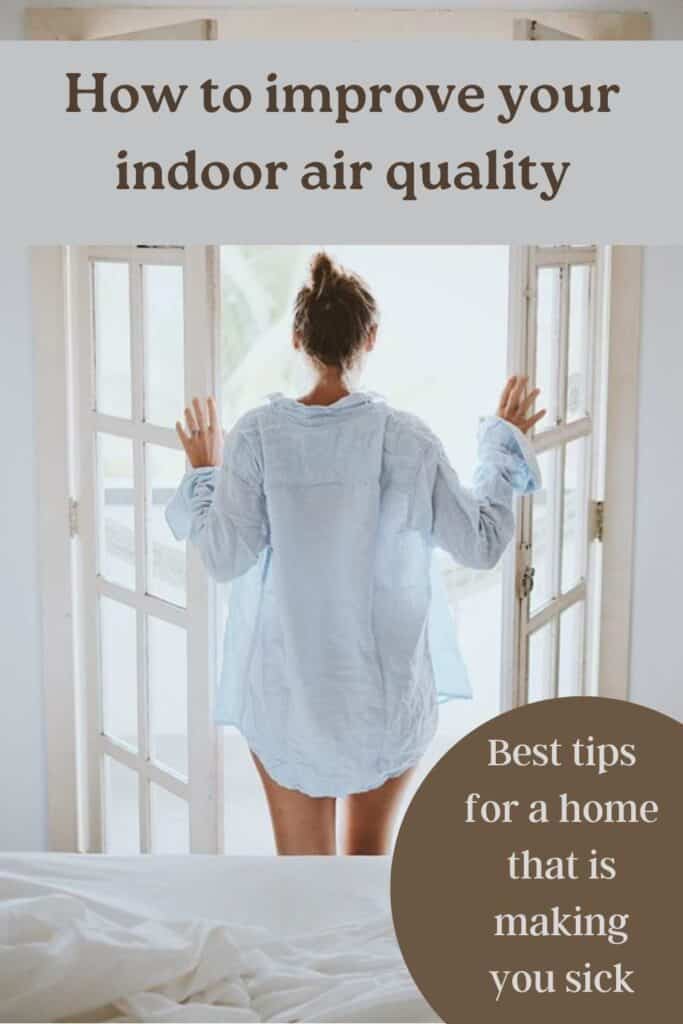
How to improve your indoor quality?
The biggest reason why your home is making you sick, the air you breathe. Dozens of toxic chemicals (like pesticides, heavy metals, and chemical flame retardants) have been found in house dust across the country. Our hands then sweep these chemicals from surface areas, furniture, and clothing. Let’s break down the best tips for a home that is making you sick!
How Do You Test Your Indoor Air Quality?
You can test your indoor air quality using an air quality monitor (this one has a built-in alarm system that will alert you when indoor air is too polluted) and a carbon monoxide detector. This is my best recommendation. You can also use kits to perform a mold and radon test. The results of these test kits are often conclusive. However, in some cases, you may need to seek professional help.
Declutter:
This is super important. Part of the reason indoor air quality gets poor is because of our accumulation of so much STUFF. More clutter = more dust = poor indoor air quality. Get rid of the stuff you don’t use or need.
Open your windows:
It sounds simple, but I see that a lot of people don’t do it. Items in our homes like the paints on our walls, our carpets, mattresses, and our upholstered furniture, can emit toxic fumes and make us sick.
Even when it is freezing. 15 minutes ideally on the less cold days but even 5 minutes when it is really cold can swap out indoor air for fresh air.
- Quick note on paints: VOC’s are chemicals used to help particles in the paint disperse as well as bind together. They out-gas at room temperature (they produce the new paint smell). These fumes can trigger flu-like symptoms, allergies, asthma and nervous system disorders. These VOC’s off-gas for years after painting, contributing to polluted indoor air. The most common VOC solvents used in paint are:
- NATURAL PAINTS AVAILABLE ON AMAZON:
Schedule HVAC Service Appointments:
The HVAC is essentially the lungs of a home. As such, it’s important to ensure that it’s operating properly and not bogged down with issues like microbial growth. When the system flips from cool air to warm air, condensation can build up within the ducts or the unit itself, which offers the perfect home for things like mold.
Change your air filters regularly. More than usual in the wintertime. Your furnace and AC have to work harder if the filters are dirty, and they could eventually start spreading the dirt and mold spores they are designed to collect.
Be mindful of what you are burning and spraying:
Most candles negatively impact indoor air quality and can contribute to making you sick. Many candles are made with paraffin wax, which is a petroleum byproduct, and fragrances that contain phthalates, a group of chemicals that have been linked to liver, kidney, lungs and reproductive system damage in animal studies.

- 100% BEESWAX IS BEST. 100% COCONUT OR SOY WAX ARE SECOND BEST. In addition to being beautiful and toxin-free, beeswax candles help clean indoor air by releasing negative ions, which bind and remove toxins from the air. They can also remove common allergens, such as dust and dander, from the air.
- Stay away from wicks with metal fillings. Wicks with metal cores, when burned, can emit lead into the air. Look for a 100% cotton wick or FSC certified sustainable wood wicks.
- Avoid fragrances and use a candle that has 100% pure essential oils.
- Other alternatives to candles are incenses or a diffuser with essential oils.
- Make your own potpourri. Dried plant material — flowers, berries, fruit rinds, wood chips, or spices — can be placed in bowls or fabric bags and set around your home.
Many conventional air fresheners contain toxins like volatile organic compounds (VOCs), phthalates, carcinogens, and allergens. These ingredients can cause allergies, cancer, infertility, and all kinds of other health issues.
Many companies will use chemicals like benzothiazolinone and methylisothiazolinone as preservatives. Unfortunately, these chemicals are known allergens and irritants. Additionally, researchers are beginning to suspect that methylisothiazolinone might be an endocrine disruptor and a neurotoxin.
If you love air fresheners, my recommendation would be to go with Dropps Revitalizing Mist. It beats using the conventional kind.
Keep your shoes at the door:
Turns out, old fashioned traditions can help reduce our body burdens (the chemical load in our bodies).
Dr. Charles Gerba at the University of Arizona conducted a study in which he got an inside look at just what’s on the bottom of the shoes we wear every day. After testing the bottoms of new shoes worn for two weeks, he found coliform and E. coli bacteria. The presence of these two bacteria indicates frequent contact with fecal matter – our shoes are as dirty as a toilet.
While the thought of our shoes being as contaminated as a public restroom is scary, that wasn’t the scariest finding in the study. Dr. Gerba found that the shoes in his experiment had a 90-99% transfer rate of the bacteria from shoes to floors. Even over long distances, shoes can carry fecal bacteria into our homes, offices, and personal spaces.
Simple solution, take your shoes off. If you are having guests, you can easily keep shoe covers on hand or get fancy and have a shoe dispenser cover and remover for parties.
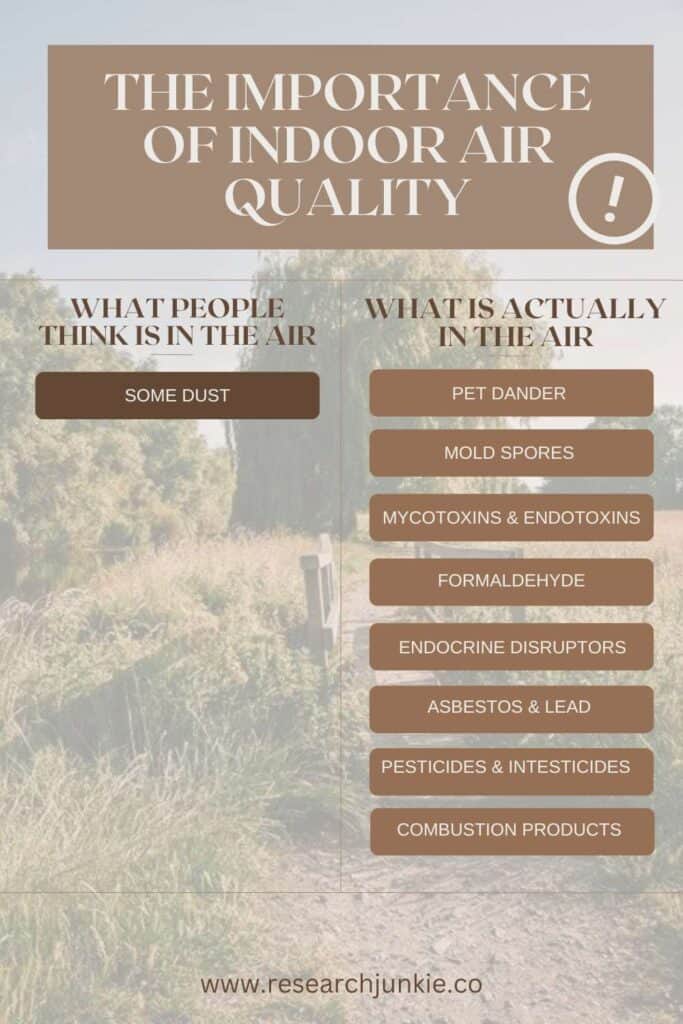
Maintain Indoor Humidity Levels Between 35-50%:
This level is the sweet spot for promoting home health.
Some species of mold can begin to grow in areas with high humidity. This moisture-rich air can cause condensation as it hits warm surfaces, creating yet another opportunity for microbial growth. All it takes is 24-48 hours on a surface with food and moisture for a spore to transition into an active colony.
A great idea is to invest in a hygrometer and continually monitor your indoor humidity levels. If it goes too far in either direction, you can then jump into action to fix it and ensure your environment remains a safe space.
Ways to keep your indoor humidity at the perfect level include:
- Focusing on airflow in bathrooms while showering
- Creating airflow in kitchens while cooking
- Investing in a dehumidifier if necessary
- Cleaning up water and spills ASAP
- Ensuring there’s adequate insulation (if you have an attic check it often)
- Increasing air circulation throughout the home
- Using the AC on hot weather days
- Fixing leaks ASAP
Invest in air purification:
Purchasing an air purifier is one of the best investments for your health and your family. It can significantly improve your overall health. I’ve lived without one for years and always thought I was fine. I was very surprised when I purchased one just how much of a difference it made in even the smallest cases.
Air Purifiers can relieve symptoms of asthma, they eliminate harmful chemicals lingering in your home, improves sleep, reduces chances of airborne diseases, and so many more benefits.
Here are my top recommendations for air purifiers:
- AIRDOCTOR AD3000 4-in-1 Air Purifier (This is the cadillac of air purifiers and the best one out there in my opinion)
- Medify MA-40 Air Purifier with H13 True HEPA Filter
- LEVOIT Air Purifiers
Cleaning products:
Cleaning products can be a major source of indoor air pollution. And product labels are not required to disclose all ingredients and potential health threats. So, it’s really hard to know which ones are safe. Instead, I enjoy more peace of mind from making my own cleaning solutions with the ingredients below. They have been used for decades without controversy—the safest track record I know of!
- Baking soda. Baking soda absorbs odors, boosts the cleaning powers of soap, and acts as a scouring agent. I sprinkle it on my stove top, toilets, sinks, and bathtubs for extra cleaning power.
- White vinegar. White vinegar fights odors, bacteria, and mold; dissolves soap scum and other buildup in toilets; cleans glass (when diluted with water); and whitens and softens laundry.
- Castille soap. Gentle and nontoxic, some Castille soaps (like Dr. Bronner’s Baby Mild) can clean your home, body, and hair.
- Hydrogen peroxide. A natural bleaching agent and antimicrobial, hydrogen peroxide is the active ingredient in many natural kitchen and bathroom cleansers. Use as a replacement for bleach.
- Steam cleaner. Using just water and electricity, a steam cleaner can effectively kill viruses, bacteria, mold, and odors without chemicals. In addition, certain relatively inexpensive ones can replace the need for ironing and sometimes dry cleaning, depending on the textile.
- Essential oils. 100% pure essential oils not only add lovely fragrance to your home, but can also help fight bacteria, fungi, viruses, and pests! Some people and pets are sensitive to certain ones so check with your doctors or vets. Key essential oils for cleaning include lemon, lavender, and tea tree oils. I use doTERRA essential oils.
- Amber-colored glass spray bottles. Essential oils should be protected from heat and light. So, if adding essential oils to your cleaning recipes, use amber- or blue- colored spray bottles.
I have an entire amazon storefront that has a ton of recommendations for cleaner non-toxic products.
Let new furniture off-gas outside:
Furniture off-gassing can release toxic chemicals into the air we breathe. Sometimes you may notice a strong odor coming from a new furniture set, other times, there is no smell. For some people, headaches, asthma and even more serious diseases like cancer may follow.
Try to allow the furniture to sit outside if possible before coming indoors and at the very least in the garage. Once inside make sure to open the windows to air out the off gassing.
- Avoid furniture with stain or water protectant.
- Buy organic mattresses or buy a mattress pad that filters out potentially harmful chemicals and gasses. Naturepedics are amazing organic mattresses and also have so many other organic products like pads, sheets, covers, and pillows. (Use code Jessbandy15 for 15% off your entire order!)
- Avoid flame retardants. According to the Green Policy Institute, “There is no data to show that meeting TB117 (California regulation) improves fire safety, but there is data showing that the flame retardants are associated with hormone disruption, developmental toxicity, and cancer in many animal studies and a small number of human studies.”
- Buy locally sourced, solid wood furniture.
- Buy GREENGUARD certified furniture. The certification “ensures that a product has met some of the world’s most rigorous and comprehensive standards for low emissions of volatile organic compounds (VOCs) into indoor air.”
- Buy second hand furniture to cut down on your exposure to furniture off-gassing, since the levels go down after several years.
- Avoid furniture made of composite materials, particle board.
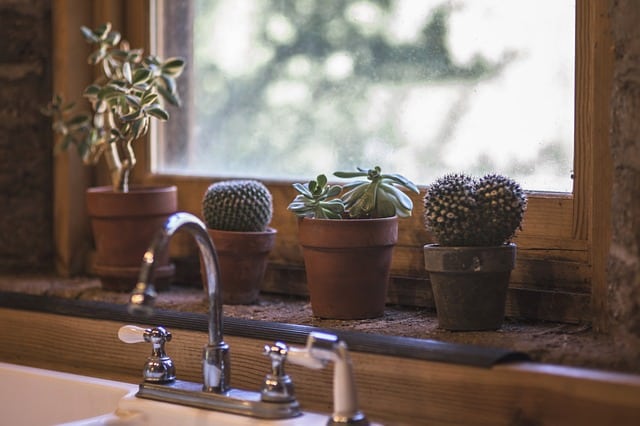
Indoor plants:
This is one of my favorite ways to clear the air. Before I came a mama to my baby boy, I was first a plant mom. I learned the importance different plants have and the benefits they promote by having them indoors.
Plants naturally convert the carbon dioxide in the air to oxygen for us to breathe, recycling the air. NASA studied which plants were most effective at cleaning the air of toxins like formaldehyde and carbon monoxide. The full list can be found here.
Mold exposure 101
Mold spores are airborne and are invisible to the naked eye. Every indoor environment has the potential for mold when the spores are introduced in the ideal conditions, specifically warm and damp areas.
There are so many cases where occupants don’t even realize they are living amongst mold and the effects it has on your health is tremendous.
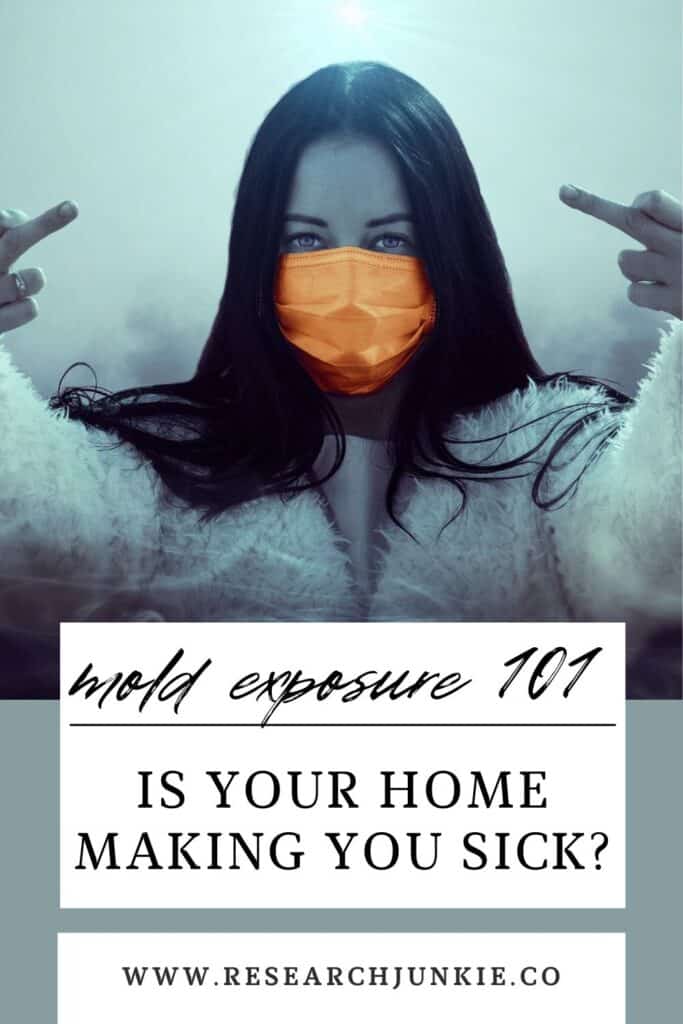
What are mold symptoms?
- red and dry itchy eyes
- Sensitivity to light
- dark circles
- jaundice
- frequent sneezing
- nasal congestion
- post nasal drip
- allergies (espesially sudden on set)
- pale, red face
- mouth sores
- dry/sore throat/throat clearing
- chronic cough
- reoccuring illness
- heat/cold tolerence
- frequent heavy sigh/yawning
- leptin resistance
- thyroid issues
- swollen lymph nodes
Now this list doesn’t mean that someone who has nasal congestion or pale skin, or a sore throat must have mold toxicity. Addressing diet and nutritional deficiencies can take care of A LOT of these symptoms. So, if you have already dialed that in, then I would not go straight to mold unless you have a strong gut feeling otherwise.
If you’re one of those who has been addressing diet and other issues for quite some time and things ARE NOT improving or are worsening, then you really NEED to consider the environment.
Some huge red flags for me…
is the sudden onset of any of these things after a move or water/intrusive leak. Even slow progression of many symptoms over time and multiple children with various symptoms makes me consider the environment.
Locations in Your Home Where Mold Can Hide
- Underneath kitchen sink base cabinet (behind the toe kick)
- Behind dishwasher
- Underneath the bathroom vanity shelf (behind the toe-kick)
- Supply vent duct in bedroom, office, etc
- Evaporator Coil inside furnace
- Insulation sound liner inside furnace
- Wall cavities below leaky windows
- Under refrigerator
- Inside furnace mounted humidifier
- On dehumidifier filter or coil
- in air cleaner carbon filter
- On upholstered furniture
- Underneath carpeting, especially if pet accidents occurred
- On floor joists in basements and crawlspaces
- Between fiberglass insulation and vapor barriers in walls
- Behind baseboards in damp areas (Laundry room, bathrooms, basement)
- On fridge door gaskets or washing machine gaskets
- In corners of damp or crowded closets
- In attics: in insulation, on rafters or sheathing
- Underneath basement stair
Tips to Decrease Mold Exposure:
Homeowners must be their own investigator! You must look for mold with a high-quality LED flashlight. Suspicious areas identified can easily be tested by a professional.
- Removing the problem and removing yourself is step one. Then for yourself and family it will come down to drainage, detoxing, and replenishing.
- Mold cleanup simply means removing the mold, so technically just a sponge or rags would do the job. Once mold is removed from a surface (via HEPA-vacuuming, scraping, wet scrubbing, wet wiping, etc.), the surface can be cleaned with a number of products like soap and water, hydrogen peroxide (highly recommend this brand), or Borax and water (1 cup to a gallon).
- Be sure the home has adequate ventilation, including exhaust fans. And use them when people shower and bathe.
What to do if you can’t leave a moldy environment?
Limit exposure
If only it were that easy, right? But seriously, if you know your home is a problem, spend as much time out of the home as possible. Preferably outdoors, even if it’s winter! Nature is tremendously healing.
Address the air
Follow the tips above to improve your indoor air quality. Get at least one air purifier and keep air flow going with windows open year-round.
Address the dust
Mold can literally grow on dust. Clutter encourages dust. Remove everything from the home you do not need especially porous items like all paper/cardboard, decorative pillows, clothing, old mattresses you’re not using. Dust every 2-3 days and wipe down your wet shower daily.
EMF’s and Toxins. EMF’s drive mold to release significantly more mycotxins. They also weaken the immune system. Read here about ways to reduce EMF exposure in your home.
Diffuse and fog
Invest in a fogger. I would fog after I cleaned. EC3 is a great brand that has mold concentrates and sprays that you can use.
Supporting your body
This is crucial. One of the ways mold makes a significant impact is by congesting the liver. Supporting the liver with castor oil packs and something like liver detox from perfect supplements is very helpful.
The next thing is minerals! Mold=stress, Stress=depleted minerals! Adrenal cocktails from jig saw health (BANDY10 for $10off) and smidge magnesium can help replenish.
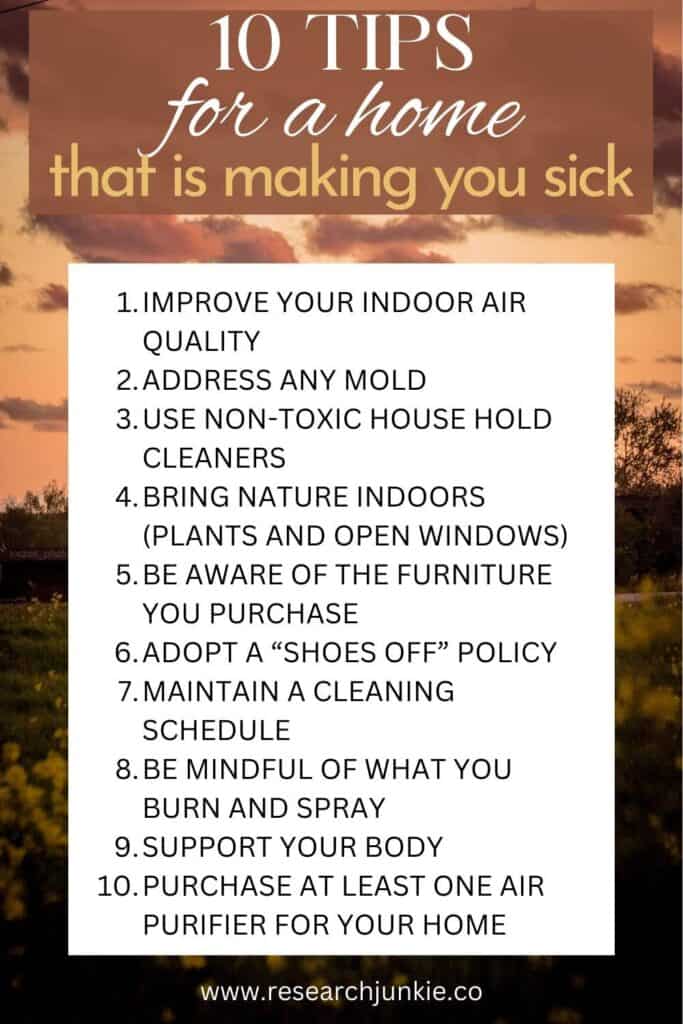
10 best tips for a home that is making you sick
That was pretty long winded, huh? There’s no way to make this cut and dry and I really wanted to dig in deep in all the ways that your home could be making you sick. Most doctors won’t even acknowledge this. If you experience constant symptoms, then you need to evaluate the “constants” in your life.
If there is something, to some degree you are experiencing everyday then there is likely something structural, dietary, lifestyle or environmental that is causing the symptoms. We need to ask ourselves what are some of the constants in our lives that could be contributing?
- Improve your indoor air quality
- Address any mold
- Use non-toxic house hold cleaners
- Bring nature indoors (plants and open windows)
- Be aware of the furniture you purchase
- Adopt a “shoes off” policy
- Maintain a cleaning schedule
- Be mindful of what you burn and spray
- Support your body
- Purchase at least one air purifier for your home
I hope you found this helpful!
Share your thoughts below and Pin for later =D
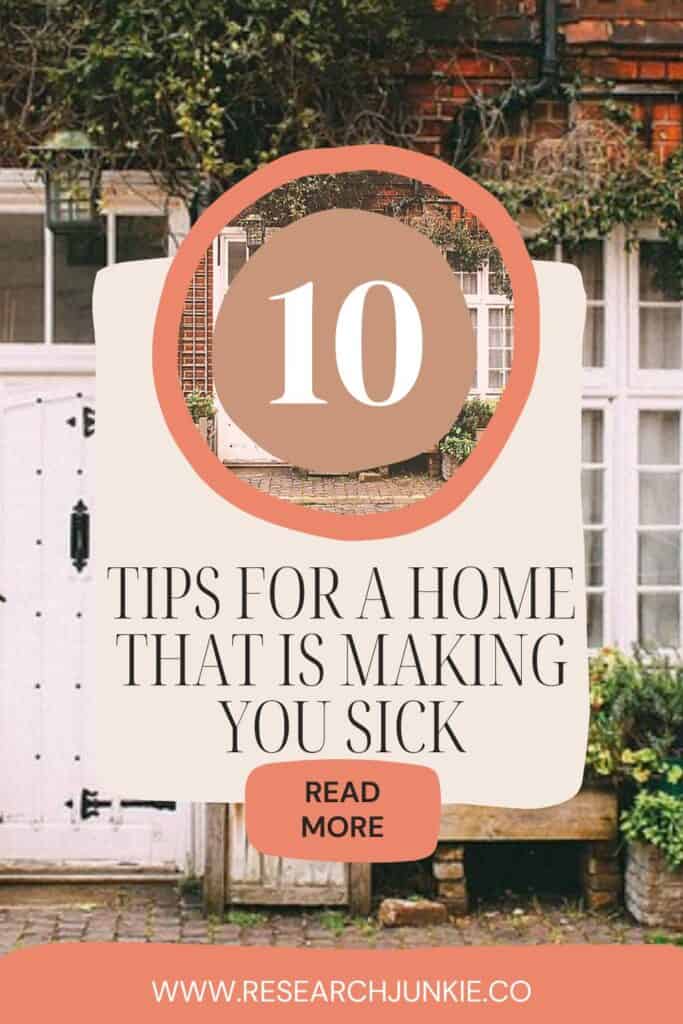
Disclaimer: I am not a doctor or medical professional, and this post should not be taken as medical advice. Please do your own research. Material on this blog is provided for informational purposes only. It is general information that may not apply to you as an individual and is not a substitute for your own doctor’s medical care or advice.







Wow, this is a really thorough blog post. Thanks for putting this together!
Thanks so much for taking the time to read this 🙂
I needed this post. I have all of these symptoms and I have wondered myself for some time if indoor air quality might be a huge contributor. As well as we’ve found mold in several areas since there was water damage to the home prior to us purchasing it. Super interested in all you have to offer. Thanks so much for putting this post together!
Mold can be such a huge factor for declining health. IHopefully can get the problem under control soon! I’m glad I can be helpful for you.
Lots of good information and very thorough.
Thank you.
Thank you for taking the time to read it 🙂
Wow! Lots of good information here! We recently got air purifiers for most of the rooms in our house. After reading this, I think I need to look into some plants and rethink all my cleaning supplies.
Yes, so happy to hear this. You are on the right track!
Ahhh! I’m so happy reading this bc it coincides with small changes I’ve been making!
Such an informative post. Thank you so much. I will definitely be applying some of these suggestions.
I blog often and I seriously thank you for your information. This great article has truly peaked my interest.
I will take a note of your blog and keep checking for new information about once per
week. I subscribed to your RSS feed as well.
Review my website – trifield electric field